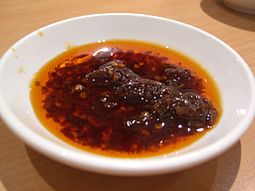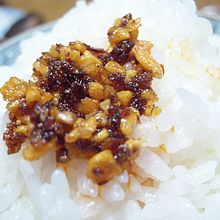- Chili oil
-
Chili oil 
Chinese name Traditional Chinese 辣油, 紅椒油, 紅油, 辣椒油, 紅辣椒油 Simplified Chinese 辣油, 红椒油, 红油, 辣椒油, 红辣椒油 Transcriptions Mandarin - Hanyu Pinyin làyóu, hóngjiāo yóu, hóng yóu, làjiāo yóu, hóng làjiāo yóu Japanese name Kanji ラー油, 辣油 Transcriptions - Romaji rāyu Korean name Hangul 고추기름 Transcriptions - Revised
Romanizationgochu gireum Thai name Thai น้ำมันพริก RTGS nam mun phrik Vietnamese name Vietnamese ớt sa tế, ớt satế Chili oil (also called hot chili oil or hot oil) is a condiment made from vegetable oil that has been infused with dried chili peppers and sometimes also additional ingredients. It is commonly used in Chinese cuisine, East and Southeast Asia and elsewhere. Particularly popular in Sichuan cuisine, it is used as an ingredient in cooked dishes as well as a condiment. It is sometimes used as a dipping sauce for meat and dim sum. It is also employed in the Korean Chinese noodle soup dish jjamppong.
Chili oil is typically red in color. It is made from vegetable oil, often soybean oil or sesame oil, although olive oil or other oils may be used. Other spices may be included such as Sichuan pepper, garlic, or paprika. The spices are soaked in oil. Commercial preparations may include other kinds of oil, water, dried garlic, soy sauce, and sugar. Recipes targeted to Western cooks also suggest other popular oils such as rapeseed, grapeseed or peanut, and any dried or fresh chili peppers. The solids typically settle to the bottom of the container in which it is stored. When using chili oil, the chef or diner may choose how much of the solids to use; sometimes only the oil is used, without any solids.
Chili oil is commercially available in glass jars, although it may also be made from scratch at home.[1] It is usually available by request at Chinese restaurants.
Japan
The Japanese variety of Chinese chili oil is known as rāyu (ラー油 or 辣油), used in Japan as a cooking ingredient or as a condiment. The default kind is typically a clear, chili-infused sesame oil, and the chopped chili pepper used is typically red, imparting a reddish tint to the oil.[citation needed] Other ingredients used may include soy oil, corn oil, dried aloe, ginger, guava leaves, leek leaves, paprika, and turmeric.[citation needed]
Beginning in 2009, a new type of product known as taberu rāyu (食べるラー油 or -辣油, literally, "rāyu for eating") became a trend in 2010[2]. This variety is known for reduced spiciness, and in addition to the usual oil, chunks of food are included such as fried garlic and fried onion. However, the variety that includes food in the chili oil, as noted above, has existed in China since ancient times.
References
Categories:- Chinese condiments
- Condiments
- Dips
- Japanese condiments
- Vegetable oils
- Condiment stubs
- Chinese cuisine stubs
Wikimedia Foundation. 2010.

